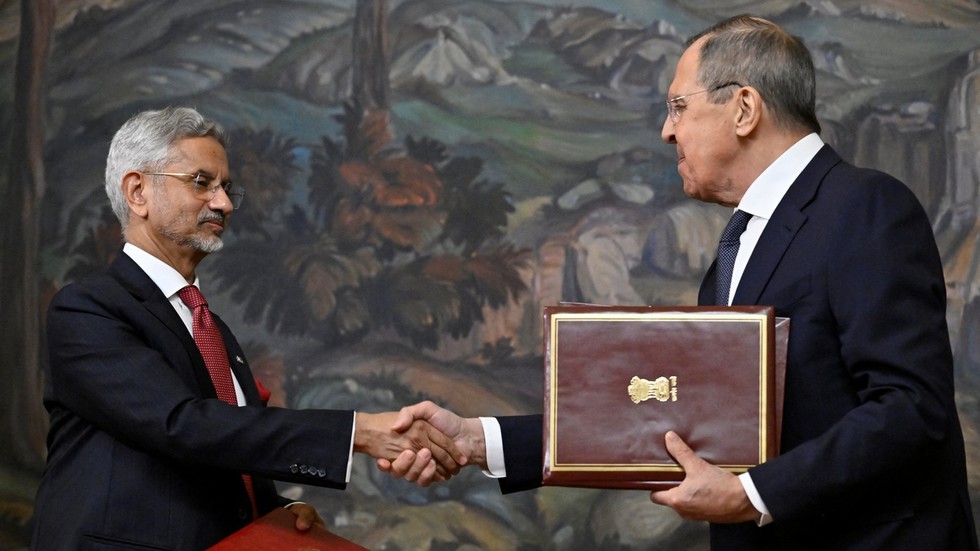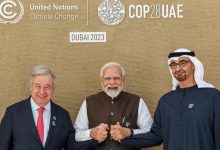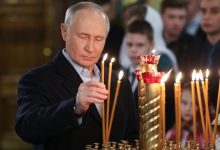
Russia’s respect for India’s policy of strategic autonomy is the core strength of bilateral ties, as the Indian foreign minister’s latest visit proves
Russian FM Sergey Lavrov (R) and Indian FM Subrahmanyam Jaishankar (L) following talks in Moscow, December 27, 2023. © Alexander NEMENOV / POOL / AFP
Indian External Affairs Minister Subrahmanyam Jaishankar’s five-day official visit to Russia was timely and significant for more than one reason.
India and Russia had held annual summits at the leadership level since 2000. This sent an important message in terms of the value attached by the two countries to bilateral ties, but it also conveyed a broader geopolitical message to other international partners of the two countries.
But this practice was broken largely because of Russia’s pre-occupation with the Ukraine conflict and its fallout. The last annual summit took place in 2021.
Indian Prime Minister Narendra Modi and Russian President Vladimir Putin could have held a summit on the margins of the BRICS summit in Johannesburg in South Africa or the G20 summit in New Delhi, but Putin did not attend either. While Jaishankar’s visit does not substitute for a summit meeting, it was intended to fill a political gap.
Jaishankar and Russian Foreign Minister Sergey Lavrov have met six times during the year, and the Indian external affairs minister also met with Russian Deputy Prime Minister Denis Manturov during the year on the economic agenda. For Jaishankar to visit Russia before the end of the year, undeterred by the Russian winter and holiday season, reflects the importance both sides attach to the further expansion of ties.
Read more
Putin has on several occasions praised the Indian prime minister and positively noted the country’s economic progress. At the ‘Russia Calling’ Forum in early December this year, he said that despite pressure from others, he “cannot imagine that Modi could be frightened, intimidated or forced to take any actions, steps, decisions that would at variance with the national interest of India and the Indian people.” He noted that sometimes he is surprised at Modi’s tough stance on Indian national interests. He added that the policy pursued by Modi is the “main guarantor” of the developing bilateral ties.
This is high and unusual praise by Putin. It can be interpreted on several levels – particularly as an acknowledgement that India has resisted pressure from the US and others to condemn Russia over the Ukraine conflict, impose sanctions, and reduce defense ties with Russia. India has, on the contrary, bought discounted Russian oil to the point that Russia has become its biggest oil supplier. It has argued that ensuring this market flow of Russian oil has helped avoid a major spike in oil prices and checked global inflation. Indian-Russian trade has expanded, while the G7 has broken economic and trade ties with Russia.
India played a major role as G20 president in negotiating the part in the Leaders’ Declaration on the Ukraine conflict despite the hardening of the G7 position and that of Russia and China after the G20 summit in Bali. The final text does not mention Russia by name, while the G7 was satisfied that the general formulations in it could be sold as being directed at Russia’s military operation in Ukraine.
Read more
Not surprisingly, Putin complimented India for de-politicizing the G20. India chaired the SCO summit in July 2023 and participated in the BRICS summit in South Africa in August 2023. This countered G7 attempts to isolate Russia diplomatically. In fact, the New Delhi SCO Declaration spoke of more effective global institutions, a more representative, just, and multipolar world order based on international law and multilateralism, and criticized the unilateral application of economic sanctions – a clear critique of the Western-dominated global system.
It is against this backdrop that Putin received Jaishankar at the Kremlin, the first time that such a gesture has been made to him personally. The general unavailability of Putin to visiting foreign ministers is well-known.
Jaishankar delivered a personal message from Modi to Putin. During the meeting, Putin invited his “friend Modi” to visit Russia in 2024 and noted that Indian-Russian ties were on the whole developing well. He said that he had been briefing Modi on developments in Ukraine, remarking that he understands the Indian prime minister is willing to do his utmost to resolve the matter by peaceful means. He added that he would give additional information to Jaishankar on Ukraine.
READ MORE:
Russia-India trade to hit record high – minister
India has continued to strengthen ties with the US, including in the defense domain. It is a member of the Quad and a strong supporter of the Indo-Pacific concept, both of which are intended to deter China’s regional ambitions. Russia has reservations about the Quad and the Indo-Pacific concept, which it sees as the US engaging in bloc politics in Asia.
Putin’s praise for Modi and India and the gesture of receiving Jaishankar takes into consideration these realities of India’s foreign policy which are meant to safeguard the larger national interests. At the core of this is Russia’s respect for India’s policy of strategic autonomy. Jaishankar’s high-profile visit and the vigorous language used to mark the importance of India’s traditional ties with Russia would have caught Washington’s attention.
Read more
Jaishankar noted that after talks with Lavrov, “what clearly came out was that India-Russia relations remain very steady, remain very strong, they are based on our strategic convergence, on our geopolitical interests, and because they are mutually beneficial.” The two leaders discussed political cooperation within international organizations such as BRICS, the SCO, etc.
Indian-Russian trade is at an all-time high, exceeding $50 billion last year, and should pass that figure this year. It includes energy, fertilizers, coking coal, and other items, for which long term arrangements were discussed. India intends to expand investments in Russia’s oil and gas sector.
On the nuclear side, two important amendments were agreed to which will take the Kudankulam nuclear power project forward. Mutual investments, progress on a bilateral investment treaty, and the resumption of negotiations between India and the Eurasian Economic Union for a free trade agreement will be resumed in the second half of January 2024.
Moscow and New Delhi will expand cooperation in the Russian Far East. India expects a large representation from this region at the Vibrant Gujarat Summit in January 2024.
READ MORE:
Moscow outlines untapped markets for Indian investments
Connectivity between India and Russia will be critical for expanding trade ties – connectivity from western India through the International North-South Transport Corridor, and connectivity from eastern India, from Chennai to Vladivostok, and the polar route. To promote tourism, India is open to increasing the number of flights from India every week.
The talks between Jaishankar and Lavrov were comprehensive. They discussed the global strategic situation, Ukraine, Gaza, the Indo-Pacific, ASEAN, Afghanistan, UN-related matters, the challenges facing the Global South, and the building of a multipolar order. China would undoubtedly have been discussed, but diplomatic discretion here would be normal.
In the joint press conference, Lavrov spoke of prospects for more defense cooperation, including joint production of modern weapons under New Delhi’s ‘Make in India’ program, and, importantly, expressed respect for India’s efforts to diversify its defense ties. He noted bilateral cooperation in rocket engine manufacturing and satellite navigation systems.
Jaishankar’s visit was productive in maintaining the momentum of Indian-Russian ties, which have been built over 60 years, a relationship that he believes is not just about politics, diplomacy, or economics, but is much deeper.
Where India Meets Russia – We are now on WhatsApp! Follow and share RT India in English and in Hindi
The statements, views and opinions expressed in this column are solely those of the author and do not necessarily represent those of RT.




